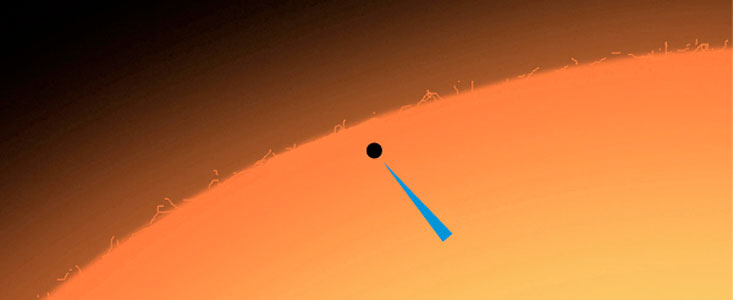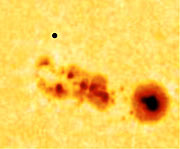Press Release
A Solar Mini-Eclipse on May 7, 2003
Planet Mercury Passes in Front of the Solar Disk
2 May 2003
A solar mini-eclipse! On May 7, 2003, Mercury, the innermost planet in the solar system, will pass in front of the Sun and produce a solar eclipse. But this event will hardly be noticed. Mercury's small disk will indeed barely be bigger than the point of a pencil. Even the smallest sunspots on the solar surface are as big as the Earth and measure 10,000 km or more in diameter, while Mercury's equatorial diameter is only 4878 km. Bathed in intense sunlight, this small, hot planet moves around the Sun in an elliptical orbit at a mean distance of only 58 million km, much closer to the Sun than other inner planet, Venus (108 million km) and the Earth (150 million km). The disk of Mercury is very small and will be very difficult to see . A powerful telescope is needed to observe this event and to show clearly how Mercury moves across the solar disk. The disk of Mercury is indeed only 13 arcseconds across (while the solar disk measures about 1800 arcseconds). This corresponds to the size of a 1 EURO coin located at the top of the Eiffel Tower as seen from the ground. Therefore, Mercury will only block 1/20,000th of the Sun's light.
Mercury Transits
Passages of Mercury in front of the Sun, or "Mercury Transits" in astronomical terminology, are comparatively rare events, due to the different orbital inclinations of the Earth and Mercury as they move around the Sun.
In order for a Mercury transit to happen, the planet must be located directly between the Earth and the Sun and also near one of the two points in its orbit where Mercury's orbital plane intersects that of the Earth. We then face the dark side of Mercury - the hemisphere that is not illuminated by the Sun - and see it as a small dark spot moving across the bright solar disk.
There are about 13 Mercury transits each century and they follow in time intervals of approximately 13, 7, 10 and 3 years. The most recent one took place in November 1999 and the next will be on May 7, 2003 and November 8, 2006 .
The next Mercury transit happens on Wednesday morning next week . It lasts from about 7:13 hrs CEST (Central European Summer Time) until 12:32 hrs CEST (5:13 to 10:32 UT) and the contour of the small planet as it moves across the solar disk can be seen from all places where the Sun is above the horizon and the sky is clear. The best observing conditions are from Europe, Africa and Asia.
Observations of the transit
Note, however, that this event cannot be observed with the unaided eye - this would also be extremely dangerous because the enormous brightness of the Sun will cause total blindness in a fraction of a second!
Observations can only be made by means of telescopes which project the solar image onto a white screen.
Public observatories, planetaria and other educational institutions will arrange special events on this occasion. News about such arrangements will appear in the local press.
Venus Transit on June 8, 2004
The Mercury Transit of May 7 is also a kind of "general rehearsal" to the even rarer Venus Transit event on June 8, 2004 . The last such event took place in 1884, so that no living person has ever seen one. The above mentioned organisations are also preparing for a major public event on that occasion. Provisional information is already available at the VT-2004 website.
Links
Live images on the web
On this special occasion and in order to provide for everybody the chance to watch this event, the European Southern Observatory (ESO) and the European Association for Astronomy Education (EAAE), together with the Institut de Mécanique Céleste et de Calcul des Éphémérides (IMCCE) and the Observatoire de Paris in France, are providing live images and a running commentary for all interested parties. It is also planned to display images obtained at observatories in the Belgium, Czechia, Hungary, Italy and Spain, and possibly others. The availability will depend on the weather situation in the various places.
Full information and many weblinks to other educational sites are available via the special website at: https://www.eso.org/public/outreach/eduoff/vt-2004/mt-2003/mt-display.html
On this site, extensive background information about Mercury and the Sun can be found and, in particular, useful sheets for school students and teachers in many languages. Live images from professional telescopes (depending on the weather at the observing sites) will be available on the special webpage: https://www.eso.org/public/outreach/eduoff/vt-2004/mt-2003/mt-display.html and it will also be possible to ask questions in "real-time" to astronomers via this page.
Contacts
Bernhard Mackowiak
ESO EPR Dept
Garching, Germany
Tel: +49-89-3200-6332
Email: bmackowi@eso.org
Jean-Eudes Arlot
IMCCE
Paris, France
Tel: +33-1-40512267
Email: arlot@imcce.fr


